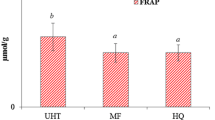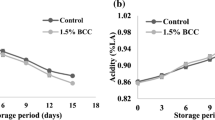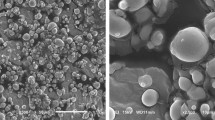Abstract
Astaxanthin has been used as a colorant and antioxidant with excellent results, its application and stability in food matrices to human consumption has been little studied. The aim of this work was the incorporation of astaxanthin oleoresin to milks with different fat content, simulating the red-orange color that can impart apricot fruit. For astaxanthin determination by HPLC, a methodology was implemented for its extraction from the food matrix, followed by saponification with KOH. Milk samples were stored (5 ± 2 °C) and stability of color and astaxanthin content were determined by colorimetry and high performance liquid chromatography each 24 h for a week. Pigment degradation followed first-order kinetic with a constant degradation of 0.259 day−1 and 0.104 day−1, in whole and semi-skimmed milk, respectively. Chromaticity coordinates L*, a*, b* for different types of milk showed a low dispersion of their values during the storage time, indicating high stability of astaxanthin within the matrix.



Similar content being viewed by others
References
Aberoumand A (2011) A review article on edible pigments properties and sources as natural biocolorants in foodstuff and food industry. World J Dairy Food Sci 6:71–78
Anarjan N, Tan CP, Nehdi IA, Ling TC (2012) Colloidal astaxanthin: preparation, characterisation and bioavailability evaluation. Food Chem 135:1303–1309
Anarjan N, Tan CP (2013) Developing a three component stabilizer system for producing astaxanthin nanodispersions. Food Hydrocolloid 30:437–447
Borowitzka MA, Huisman JM, Osborn A (1991) Culture of the astaxanthin-producing green alga Haematococcus pluvialis: I. Effect of nutrients on growth and cell type. J Appl Phycol 3:295–304
Boussiba S, Vonshak A (1991) Astaxanthin accumulation in the green alga Haematococcus pluvialis. Plant Cell Physiol 32:1077–1082
Breithaupt D (2004) Simultaneous HPLC determination of carotenoids used as food coloring additives: applicability of accelerated solvent extraction. Food Chem 86:449–456
Capelli B (2007) ASTAXANTHIN: Natural Astaxanthin; King of the Carotenoids. Published by Cyanotech Corporation, Kailua-Kona, HI. USA
Carranco ME, Calvo C, Arellano L, Pérez-Gil F, Ávila E, Fuente B (2003) Inserting Heads Shrimp Flour (Penaeus sp.) in Rations to Laying Hens. Effect of Red Pigment Concentration on the yolk and Quality Egg. Interciencia 28:328–333
Cerezal P, Barragán BE, Palma J, Ortiz C (2010) Yogurt Pigmentation with Astaxanthin and Determination of its Stability by Liquid Chromatography High Performance. IV International Congress on Food Science and Biotechnology in Developing Countries. Nov. 29th – Dec, 3rd - Veracruz, Mexico
Cerezal P, Barragán BE, Palma J, Ortiz C (2011) Use of Astaxanthin for Pigmentation of Milks and its Stability by a Short Period of Storage. VIII Iberoamerican Congress in Food Engineering (CIBIA-8). 23 to 26 October; Lima, Peru
Chattopadhyay P, Chatterjee S, Sen SK (2008) Biotechnological potential of natural food grade biocolorants. Afr J Biotechnol 7:2972–2985
Chen X, Chen R, Guo Z, Li C, Li P (2007) The preparation and stability of the inclusion complex of astaxanthin with b-cyclodextrin. Food Chem 101:1580–1584
Choubert G, Cravedi JP, Laurentie M (2009) Effect of alternate distribution of astaxanthin on rainbow trout (Oncorhynchus mykiss) muscle pigmentation. Aquaculture 286:100–104
Christophersen AG, Jun H, Jorgensen K, Skibsted LH (1991) Photobleaching of astaxanthin and canthaxanthin—quantum-yields dependence of solvent, temperature, and wavelength of irradiation in relation to packaging and storage of carotenoid pigmented salmonoids. Z Lebensm Unters F A 192:433–439
Coral-Hinostroza GN, Ytrestoyl T, Ruyter B, Bjerkeng B (2004) Plasma appearance of unesterified astaxantin geometrical E/Z and optical R/S isomers in men given single doses of a mixture of optical 3 and 3’R/S isomers of astaxanthin fatty acyl diesters. Comp Biochem Phys C 139:99–110
Czygan FC (1968) Zum Vorkommen von Crustaxanthin (3,3V,4,4V-Tetraoxi-h-carotin) und Phoenicopteron (4-Oxo-acarotin) in Aplanosporen von Haematococcus pluvialis Flotow em. Wille. Flora A 159:339–345
Forsberg OI, Guttormsen AG (2006) A pigmentation model for farmed Atlantic salmon: nonlinear regression analysis of published experimental data. Aquaculture 253:415–420
Gouveia L, Rema P, Pereira O, Empis J (2003) Colouring ornamental fish (Cyprinus carpio and Carassius auratus) with microalgal biomass. Aquacult Nutr 9:123–129
Granado-Lorencio F, López-López I, Herrero-Barbudo C, Blanco-Navarro I, Cofrades S, Pérez-Sacristán B, Delgado-Pando G, Jiménez-Colmenero F (2010) Lutein-enriched frankfurter-type products: physicochemical characteristics and lutein in vitro bioaccessibility. Food Chem 120:741–748
Grung M, D’Souza FML, Borowitzka M, Liaaen-Jensen S (1992) Algal carotenoids 51. Secondary carotenoids 2. Haematococcus pluvialis aplanospores as a source of (3S, 3’S)- astaxanthin esters. J Appl Phycol 4:165–171
Higuera-Ciapara I, Valenzuela LF, Goycoolea FM (2006) Astaxanthin: a review of its chemistry and applications. Crit Rev Food Sci Nutr 46:185–196
Hong SI, Han JH, Krochta JM (2004) Optical and surface properties of whey protein isolate coatings on plastic films as influenced by substrate, protein concentration, and plasticizer type. J Appl Polym Sci 92:335–343
Jing P, Giusti M (2005) Characterization of Anthocyanin-Rich Waste from Purple Corncobs (Zea mays L.) and Its Application to Color Milk. J Agric Food Chem 53:8775–8781
Jorgensen K, Stapelfeldt H, Skibsted LH (1992) Fluorescence of carotenoids. Effect of oxygenation and cis/trans isomerization. Chem Phys Lett 190:514–519
Kang EJ, Campbell RE, Bastian E, Drake MA (2010) Annatto usage and bleaching in dairy foods. J Dairy Sci 93:3891–3901
Kimura M, Rodriguez-Amaya DB (1999) Source for errors in the quantitative analysis of food carotenoids by HPLC. Arch Latinoam Nutr 49:58–66
Krammerer D, Schillmoller S, Maier O, Schieber A, Reinhold C (2007) Colour stability of canned strawberries using black carrot and elderberry juice concentrates as natural colorants. Eur Food Res Technol 224:667–669
Lignell A, Inborr J (2002) Immunoglobulin-rich milk, production and use thereof. US Patent 6475547:B1
Lorenz RT, Cysewski GR (2000) Commercial potential for Haematococcus microalgae as a natural source of astaxanthin. Trends Biotechnol 18:160–167
Lüddecke E, Auweter H, Schweikert L (2004) Use of carotenoid aggregates as colorants. US Patent 6827941:B1
Mendi SD, Peter B, Kamga T (2000) The effects of pH and heat treatments processing on the stability of natural food colours used in dairy products. J Food Tech Afr 5:59–61
Miyazawa T, Nakagawa K, Kimura F, Satoh A, Miyazawa T (2011) Plasma carotenoid concentrations before and after supplementation with astaxanthin in middle-aged and senior subjects. Biosci Biotechnol Biochem 75:1856–1858
Moerck RE (2012) Valensa Introduces New ‘Body Ready’ Astaxanthin Formulation for Optimal Absorption www.ereleases.com/pr/valensa; accessed on 12.10.2012
Mortensen A (2006) Carotenoids and other pigments as natural Colorants. Pure Appl Chem 78:1477–1491
Niamnuy C, Devahastin S, Soponronnarit S, Raghavan GSV (2008) Kinetics of astaxanthin degradation and color changes of dried shrimp during storage. J Food Eng 87:591–600
Nielsen BR, Mortensen A, Jorgensen K, Skibsted LH (1996) Singlet versus triplet reactivity in photodegradation of C40 carotenoids. J Agric Food Chem 44:2106–2113
Obón JM, Castellar MR, Alacid M, Fernández-López JA (2009) Production of a red–purple food colorant from Opuntia stricta fruits by spray drying and its application in food model systems. J Food Eng 90:471–479
Okada Y, Ishikura M, Maoka T (2009) Bioavailability of astaxanthin in Haematococcus algal extract: the effects of timing of diet and smoking habits. Biosci Biotechnol Biochem 73:1928–1932
Pacheco-Palencia LA, Hawken P, Talcott ST (2007) Juice matrix composition and ascorbic acid fortification effects on the phytochemical, antioxidant and pigment stability of acai (Euterpe oleracea Mart.). Food Chem 105:28–35
Pérez-Gálvez A, Mínguez-Mosquera MI (2005) Esterification of xanthophylls and its effect on chemical behavior and bioavailability of carotenoids in the human. Nutr Res 25:631–640
Quan C, Turner C (2009) Extraction of astaxanthin from shrimp waste using pressurized hot ethanol. Chromatographia 70:247–251
Rădulescu G, Mocanu E, Caraene G, Ciuhu I, Mănăilă N, Săvoiu G, Eremia CM, Dumitru RI (2007) Studies concerning the obtainment of astaxanthin, an important natural pigment used in cosmetic, food and pharmaceutical industries. Lucrari Stiintifice: Zootehnie si Biotehnologii 40:158–162
Raj G (2010) Chemical kinetics, 8th edn. Krishna Prakashan Media P Ltd; GOEL Publishing House, Meerut
Ribeiro HS, Ax K, Schubert H (2003) Stability of lycopene emulsions in food systems. J Food Sci 68:2730–2734
Spolaore P, Joannis-Cassan C, Duran E, Isambert A (2006) Commercial applications of microalgae. J Biosci Bioeng 101:201–211
Tan CP, Nakajima M (2005) β-Carotene nanodispersions: preparation, characterization and stability evaluation. Food Chem 92:661–671
Wallace TC, Giusti MM (2008) Determination of color, pigment, and phenolic stability in yogurt systems colored with nonacylated anthocyanins from Berberis boliviana L. as compared to other natural/synthetic colorants. J Food Sci 73:241–248
Walsh MK, Brown RJ (2000) Use of amino acid analysis for estimating the individual concentrations of proteins in mixtures. J Chromatogr A 891:355–360
Wang WD, Xu SY (2007) Degradation kinetics of anthocyanins in blackberry juice and concentrate. J Food Eng 82:271–275
Ytrestøyl TK, Bjerkeng B (2007) Dose response in uptake and deposition of intraperitoneally administered astaxanthin in Atlantic salmon (Salmo salar L.) and Atlantic cod (Gadus morhua L.). Aquaculture 263:179–191
Yuan JP, Chen F (1999) Hydrolysis kinetics of astaxanthin esters and stability of astaxanthin of Haematococcus pluvialis during saponification. J Agric Food Chem 47:31–35
Zhao L, Zhao G, Chen F, Wang Z, Wu J, Hu X (2006) Different effects of microwave and ultrasound on the stability of (all-E)-astaxanthin. J Agric Food Chem 54:8346–8351
Acknowledgments
This study was supported by the National Commission for Scientific and Technological Research (CONICYT) of Chile, through the financing of Convention Attraction of Human Capital Advanced Foreigner in his mode of short stay (MEC) (Folio No. 80095006; years 2010–2011) as well as Project Codigue N°. 2009–091 (years 2010–2011) belonging to the bilateral program of scientific collaboration between the National Council of Science and Technology (CONACYT) of Mexico and CONICYT of Chile. Similarly the University of Antofagasta through the Food Department and Research Department provided all reagents and equipment used. The Company Atacama Bionatural Products Inc. also provided pigment astaxanthin used in this study.
Author information
Authors and Affiliations
Corresponding author
Rights and permissions
About this article
Cite this article
Mezquita, P.C., Huerta, B.E.B., Ramírez, J.C.P. et al. Milks pigmentation with astaxanthin and determination of colour stability during short period cold storage. J Food Sci Technol 52, 1634–1641 (2015). https://doi.org/10.1007/s13197-013-1179-4
Revised:
Accepted:
Published:
Issue Date:
DOI: https://doi.org/10.1007/s13197-013-1179-4




